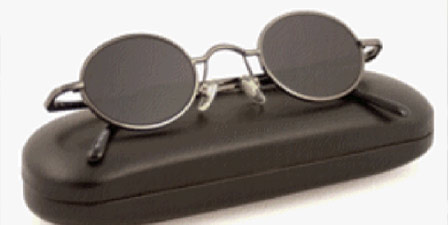Well, the election’s over.
In an effort to bring some levity to an exceptionally divisive year at the poles, I looked back at a more innocuous political topic in November’s issue of 20/20 — the secret history of LBJ’s eyeglass collection. Unfortunately, my hopes that the article would be read amidst a new atmosphere of love, acceptance, and impromptu kumbaya sessions have been pretty heavily dashed. I’m wondering now if maybe I shouldn’t have waited to pull out the big guns until after the election was over. I certainly don’t have anything quite as big as Johnson’s impressive cache of frames to try and inject some optimism —at least not until JFK’s solid gold and jewel encrusted Wayfarers turn up. That said, I was able to dig up a bit of no less important optical history to serve as the subject of this month’s article: President Dwight D. Eisenhower’s glasses.
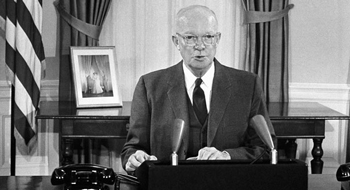 With only JFK between them, Eisenhower and Johnson’s approach to eyeglasses presents an interesting perspective on their respective generation’s feelings about eyewear. But before we get into semiotics, let’s take a look at Eisenhower’s eye health.
With only JFK between them, Eisenhower and Johnson’s approach to eyeglasses presents an interesting perspective on their respective generation’s feelings about eyewear. But before we get into semiotics, let’s take a look at Eisenhower’s eye health.
While Johnson had moderate hyperopia, Eisenhower had exceptional vision. A look at his RX from 1927, provided to me courtesy of the Eisenhower Presidential Library, Abilene, Kansas, reveals that even at the age of 37 his OD distance acuity was 20/15, 20/20 OS. After he complained of “an occasional congestion and irritation of the eyes,” Eisenhower was prescribed an incredibly mild reading RX of +0.50 DS, +0.50 +0.25 x 090. Four years later, in 1931, when Eisenhower continued to complain that his eyes “[felt] uncomfortable when doing close work,” his RX was slightly increased, to +0.50 +0.25 x 090/ +0.75 +0.50 x 90. Notably, his distance vision remained quite sharp: While his OS distance acuity was slightly degraded to 20/30, he remained 20/15 in his OD.
Remarkably, Eisenhower’s acuity would remain stable for roughly the next fifteen years, other than vaguely described “episodes of sore eyes” now believed to be conjunctivitis, with allergies also an occasional suspect. (A look at Eisenhower’s general eye health over the course of his life demonstrates that he suffered “frequent irritation of the eyes” throughout his life, now thought to be conjunctivitis, which was treated with antibiotics and local medications).
 Although he was able to enjoy exceptional vision for a long period of time, natural aging finally caught up with Eisenhower in his later years, and throughout his time in office, his RX was steadily increased to compensate for worsening presbyopia and some minor hyperopia. By the time he left office, he had a distance RX of +1.00 DS/+1.50 +0.50 x 075, with a reading RX of +3.75 -0.25 x 180/+1.50 -0.50 x 175.
Although he was able to enjoy exceptional vision for a long period of time, natural aging finally caught up with Eisenhower in his later years, and throughout his time in office, his RX was steadily increased to compensate for worsening presbyopia and some minor hyperopia. By the time he left office, he had a distance RX of +1.00 DS/+1.50 +0.50 x 075, with a reading RX of +3.75 -0.25 x 180/+1.50 -0.50 x 175.
It’s here we get into Eisenhower’s eyewear. In notable contrast to LBJ, Eisenhower left behind little in the way of glasses. The single pair of frames in possession of the Eisenhower Library are translucent grey zyl Bausch and Lomb frame; a popular choice in the era for men wanting to minimize the appearance of their frames while having something slightly more durable than rimless. The records provided by the Presidential Library indicate that Eisenhower had few backup pairs of glasses. Officially, the Eisenhower Library’s records mention a of pair golfing glasses prescribed during his presidency, which, as of press time, haven’t turned up as a result of any of my inquiries.
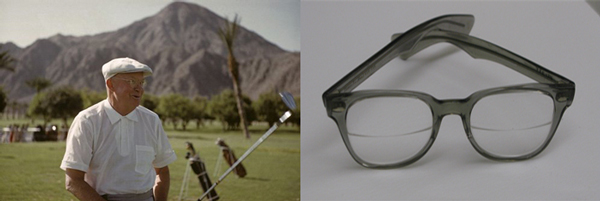
I was able to dig up a single photo of Eisenhower golfing, which depicts him wearing what appear to be a pair of round glasses, though it’s difficult to tell whether they’re totally rimless, a Rimway style semi-rim, or just very fine wire rims. At present, it would appear as if these glasses were lost, destroyed, given away, or misplaced, though I’m hopeful that I’ll one day be writing a follow-up to this article to say they’ve turned up.
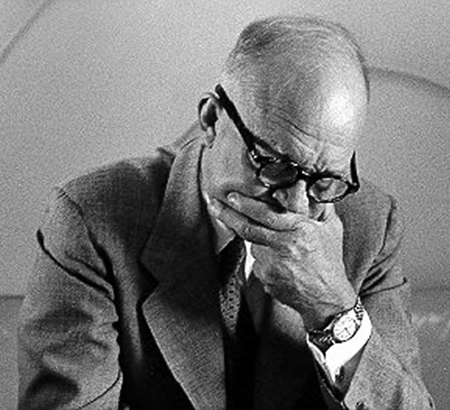
Unofficially, a candid photo of Eisenhower that tends to pop up on Rolex and general watch forums (Eisenhower was the proud owner of a Rolex Datejust, the 150,000th watch produced by the company) show him wearing a pair of round zyl glasses that appear to be either black or a very dark tortoise pattern. No information about the frames exists in the Eisenhower Library records; it’s worth noting that, uniquely for the period, the glasses have bayonet temples, more often seen on sunglass frames of the era than on general-use ophthalmics.
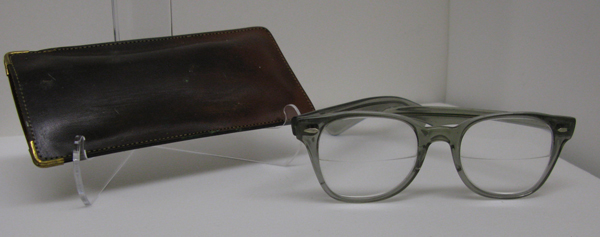
Owing to the fact that Eisenhower apparently only used these glasses while reading or giving televised addresses (most photos of Eisenhower depict him sans glasses or simply holding them), his lenses were an executive bifocal. Unlike LBJ’s extensive collection, with different models for different occasions and styles and colors that verged on the fashion-forward, Eisenhower’s glasses speak to the sensibilities of an older generation who saw them simply as a piece of medical equipment no different than a hearing aid or a crutch. While in the contemporary public consciousness Johnson was simply another middle-aged president, and appeared ancient to the college-aged Americans who protested his foreign policy, he was comparably young next to Eisenhower, who was eighteen years his senior. Ultimately, it’s a neat object lesson in both the history of eyeglass perception as well as the impact of generational differences. While there’s no telling how the future will view eyewear, the disparity between Johnson and Eisenhower’s own approaches tells us just how much things can change in a single generation, or even just a few short years.
All photos of President Eisenhower’s frames courtesy of the Eisenhower Presidential Library, Abilene, Kansas.

Preston Fassel was born in Houston, Texas and grew up between St. Charles, Missouri and Broken Arrow, Okla.
In 2009, Preston graduated Summa Cum Laude with a degree in Liberal Arts. In 2011, he graduated Cum Laude from Sam Houston State University with a Bachelor's of Science.
Preston currently works as an Optician in the Houston area. His interest in the history of eyewear goes back to his time in high school, when he developed an interest in all things vintage.
In addition to his writing for The 20/20 Opticians Handbook and 20/20 Magazine, Preston is a featured writer for Rue Morgue Magazine, where he reviews of horror and science-fiction DVDs. His fiction writing has been featured three times in Swirl magazine, the literary arts journal of Lone Star College and Montgomery County. He is the author of the definitive work on the life of British horror actress Vanessa Howard, Remembering Vanessa, which appeared in the Spring 2014 edition of Screem Magazine.



